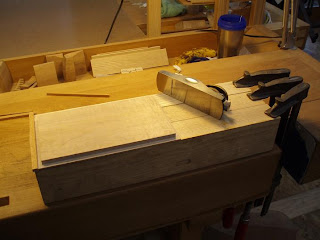
Alright! It was glue-up time for the box this week. First "calls" had to be made. These blocks are what the clamps actually contact. To be able to get a perpendicular face so the clamps could, well clamp, without moving the force up or down the calls had to be made to mate the outside curve on one face and then have a 90 degree flat on the other. This was actually easier than it sounds. I grabed the chopping block I made for the project and cut it into for equal sections. Add some padding shaped to surround the joinery and they were done.

Before the glue up could actually happen pre-finishing needed to happen. Pre-finishing covers the parts that could not be done or difficult to do after the assembly. In this case the inside faces and the bottom panel were treated with shop mixed shellac and a bit of wax.

The assembly. It's always an exciting yet nerve-racking time. The time that all your hard work brings the components home and hopefully you haven't mislabeled or misjudged something. Once put together assemblies are more often then not impossible to correct.
The count-down to the unclamping is sometimes anxious, waiting to see what comes out. Other times it just rolls by in confidence.

Moving on. Here is the rough cut panel for the lid of the box. My eye caught a small plank of curly western maple. The colors was what first got my attention opposed to the curl. It had pink undertones with greyish blue streaks and deeper pink washes. I set up this little rig so that I could round over the sides without diving into my bench. I also had taken care to straighten out the grain the best I could so I could plane this piece in both directions. This little piece came from a cut that was about 15" long and 2" thick! But the end product is worth it!

I was amazed to find out that this log had been picked up off one of the local beaches! Money may not grow on trees but sometimes things even better can be swept up beneath your feet.
















